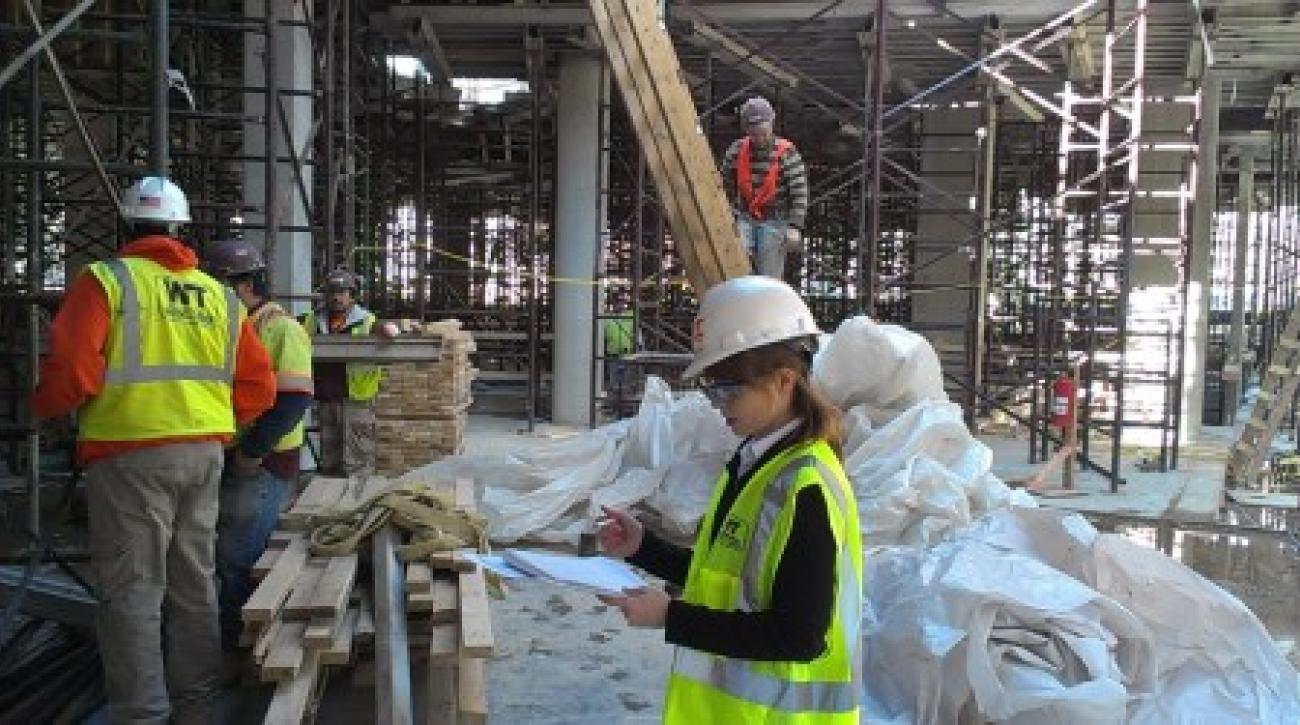For most members of the Milken Institute School of Public Health, construction of a new building at 950 New Hampshire Avenue meant a chance to bring seven departments under one roof. For Melissa Perry, chair of the Department of Environmental and Occupational Health, it also presented an opportunity to study construction safety practices.
“Hundreds of construction workers are killed on the job each year in the United States, and many of these deaths are from falls,” said Perry, who has conducted research on construction safety, including preventing falls from ladders. “We wanted to learn more about fall risks over the course of building construction, so that we can develop targeted fall-prevention programs.”
Perry’s first step was to meet with representatives of Whiting-Turner, the general contractor for the building’s construction. The company was enthusiastic about using the project to advance knowledge of construction-worker safety. “Whiting-Turner has been a highly cooperative and committed partner,” Perry said. “We couldn’t have completed this study without them.”
Assessing fall safety
With funding from the Center for Construction Research and Training, Perry and her colleagues developed a tool to assess fall hazards and fall-prevention practices among five groups of “skilled trade” workers who are at risk of falls: electricians, ironworkers, painters, carpenters, and roofers. Postdoctoral scientist Seung-Sup Kim (who has since moved on to a faculty position at Korea University) and MPH candidate Amanda McQueen reviewed existing tools for auditing fall safety and elements of fall-safety standards from the Occupational Safety and Health Administration (OSHA). Then, the team developed their own assessment tool, the George Washington Audit of Fall Risks (GAFR), with input from safety experts, and refined it following a pilot test.
Once the assessment tool was ready, McQueen attended a 30-hour OSHA construction-safety course and began conducting regular site observations to see how different potential hazards arise and how safety practices are used at the various stages of building construction. In particular, she focused on equipment used by workers in the occupations of interest (ladders, scaffolding, aerial lifts, and roof sheathing) as well as the use of site-specific fall prevention equipment such as guardrails, safety nets, and personal fall arrests (e.g., safety harnesses).
For each of the items, McQueen was looking for several specifics. “With guardrails, for instance, OSHA has several requirements – the top edge needs to be between 39 and 42 inches above the floor, there must be a parapet or second rail at least 21 inches from the floor, they need to have flags every six feet so workers can see them, and so on,” McQueen explained. “These seemingly minute details actually save lives; therefore, it was very important for me to observe them on each floor during every observation.”
In all, McQueen visited the building more than 35 times. “I did my first site observation in April of 2013, when crews were pouring concrete for the foundation, and the last one nearly a year later,” McQueen said. “Researchers are rarely able to have this kind of access to a worksite for a prolonged period of time, so this gives us an opportunity to make a unique contribution to construction-safety research.”
Findings and applications
Perry and McQueen are still analyzing their data, but preliminary findings suggest that the study will meet its objective of pinpointing jobs and situations that may pose the greatest risks to construction workers.
“From our analysis so far, we see that ironworkers and carpenters in particular spend a lot of time in situations that can be risky,” Perry said. “Knowing this, employers may want to examine their procedures for equipping and training these workers, in particular, to ensure that they’re properly protected from fall hazards.”
In addition to helping advance construction-safety research, the study has also helped shape an up-and-coming occupational health professional. McQueen will be using the study’s data for her MPH culminating project and plans to pursue a job in the occupational health and safety field. “This research project let me apply my academic knowledge and OSHA training in a real-world setting, and gave me a greater understanding of safety challenges,” said McQueen. “I came to the construction study already having a passion for worker health and safety, and now I also have stronger skills and connections I can use to turn my interests into a career.”


